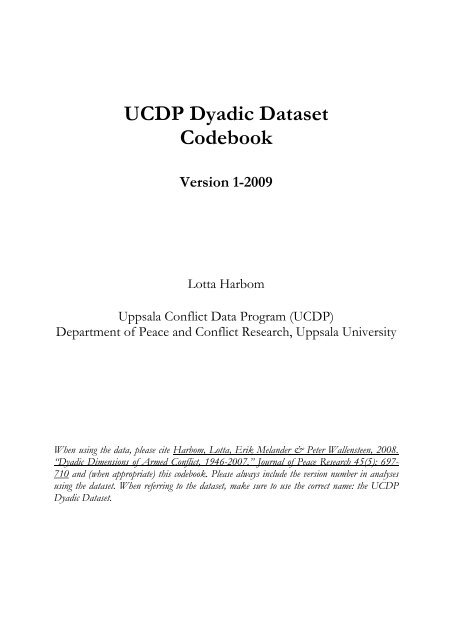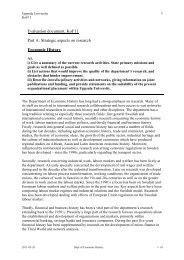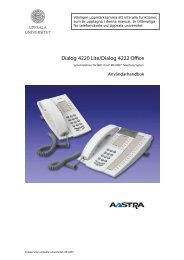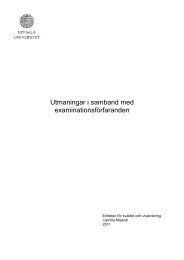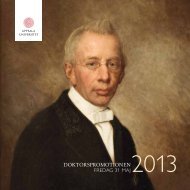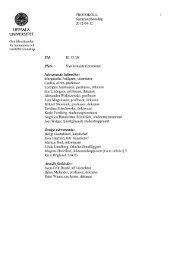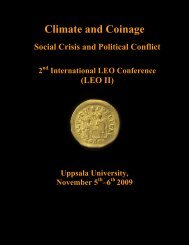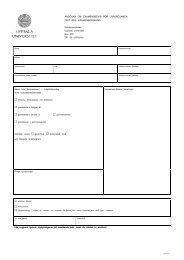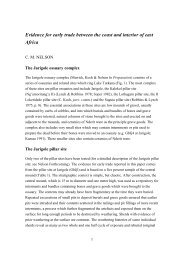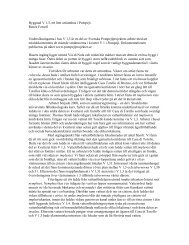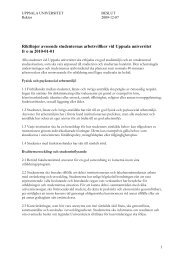UCDP Dyadic Dataset Codebook
UCDP Dyadic Dataset Codebook
UCDP Dyadic Dataset Codebook
You also want an ePaper? Increase the reach of your titles
YUMPU automatically turns print PDFs into web optimized ePapers that Google loves.
<strong>UCDP</strong> <strong>Dyadic</strong> <strong>Dataset</strong><strong>Codebook</strong>Version 1-2009Lotta HarbomUppsala Conflict Data Program (<strong>UCDP</strong>)Department of Peace and Conflict Research, Uppsala UniversityWhen using the data, please cite Harbom, Lotta, Erik Melander & Peter Wallensteen, 2008.“<strong>Dyadic</strong> Dimensions of Armed Conflict, 1946-2007.” Journal of Peace Research 45(5): 697-710 and (when appropriate) this codebook. Please always include the version number in analysesusing the dataset. When referring to the dataset, make sure to use the correct name: the <strong>UCDP</strong><strong>Dyadic</strong> <strong>Dataset</strong>.
1 IntroductionThis document describes the <strong>UCDP</strong> <strong>Dyadic</strong> <strong>Dataset</strong>, a project within the Uppsala Conflict DataProgram (<strong>UCDP</strong>), at the Department of Peace and Conflict Research, Uppsala University. Thedataset was first presented in Harbom, Melander and Wallensteen (2008) and is available fordownload from http://www.pcr.uu.se/research/<strong>UCDP</strong>/data_and_publications/datasets.htm.The <strong>UCDP</strong> <strong>Dyadic</strong> dataset builds on the <strong>UCDP</strong>/PRIO Armed Conflict dataset, but goes beyondthe conflict level and focuses on dyads within each conflict. As such, it constitutes adisaggregated version of the <strong>UCDP</strong>/PRIO Armed Conflict dataset. It is compatible with a rangeof other datasets, both provided by <strong>UCDP</strong> and by PRIO (International Peace Research Institute,Oslo).Version 1-2009 is updated in accordance to the changes listed in Harbom & Wallensteen (2009),and the 2008 conflicts have been added to the database. We refer the reader to our VersionHistory document for details of other changes and revisions to the dataset. The dataset willcontinue to be updated annually and made available simultaneously with the updated version ofthe <strong>UCDP</strong>/PRIO Armed Conflict <strong>Dataset</strong>.2 Definition of conflict and dyadThe definition of an armed conflict is fundamental to <strong>UCDP</strong>’s data collection exercise and thedyad is a key component of that definition. The main unit in this dataset is a “Conflict Dyad” asdefined by <strong>UCDP</strong>. 1 This definition is presented unabridged in section 2.2. Each conflict dyad islisted in the database and given a unique ID code.2.1 Armed Conflict<strong>UCDP</strong> defines armed conflict as: “a contested incompatibility that concerns government and/orterritory where the use of armed force between two parties, of which at least one is thegovernment of a state, results in at least 25 battle-related deaths in a year”.For an in-depth discussion of all elements of this definition, see the codebook for the<strong>UCDP</strong>/PRIO Armed Conflict <strong>Dataset</strong>.2.2 Conflict DyadA conflict dyad is two conflicting primary parties of which at least one is the government of astate. In interstate conflicts, both primary parties are state governments. In conflict dyads inintrastate and extrasystemic conflicts the non-governmental primary party is an organisedopposition organisation.The separate elements of the definition are operationalized as follows:1 For a more in-depth discussion on definitions, seehttp://www.pcr.uu.se/research/<strong>UCDP</strong>/data_and_publications/definitions_all.htm
1) Primary parties: The parties that form the incompatibility by stating incompatible positions.The incompatibility (i.e. the conflict issue) must concern governmental power (type ofpolitical system, the replacement of the central government or the change of itscomposition), territory (the status of a territory, e.g. the change of the state in control of acertain territory - interstate conflict - secession or autonomy - internal conflict) or both.2) Government: The party controlling the capital of a state.3) State: A state is an internationally recognised sovereign government controlling a specificterritory or an internationally unrecognised government controlling a specified territorywhose sovereignty is not disputed by another internationally recognized sovereigngovernment previously controlling the same territory. See section 4 for details on thesample of countries covered by this definition.4) Opposition organization: Any non-governmental group of people having announced a namefor their group and using armed force to influence the outcome of the statedincompatibility. The <strong>UCDP</strong> only deals with formally organized opposition. The focus ison armed conflict involving consciously conducted and planned political campaigns ratherthan spontaneous violence.To differentiate between dyads is at times problematic. When is a dyad completely new and whenis it simply a continuation of an already registered dyad, only slightly altered? The key difficultyhere is to distinguish between opposition organisations, as the other primary party in the dyad –the government of a state – never changes. 2 Some opposition groups tend to be fractious,splitting into different sub-groups while others join larger coalitions or umbrella groups. <strong>UCDP</strong>follows four main rules:● However many times a group changes its name, it still retains the same DyadID (forexceptions, see below).● When a group splits, the splinter group is considered a completely new oppositionorganisation, and if it continues opposing the government and all other criteria arefulfilled, it constitutes part of a new dyad in the dataset, with a new DyadID.Comment: It is sometimes difficult to determine which of the groups should be viewed asthe splinter and which should be seen as the original group, as both fractions tend toclaim to be the “real” rebel group. <strong>UCDP</strong> deals with this by tracing the main part (i.e. themost numerous) of the group, which is then coded as the original one. Should this beproblematic to determine, a second option is to trace the original leader of the group inorder to identify the original opposition organisation.● When two or more already registered groups join together under a new name in a tightcoalition with joint military operations, the new coalition is regarded as a new oppositionorganisation. If it continues to oppose the government and if all other criteria are fulfilled,it is included as part of a new dyad in the dataset, and given a new DyadID.● When an already registered group is joined by another group that has previously not beencoded as active in the dataset, the opposition organisation is viewed as a continuation ofthe former. This applies even when the name of the group is changed.Comment: It should be noted that while this rule is applied in most cases in the datasetconventional logic made it necessary to make some exceptions. Whereas the rule workswell in e.g. the case of NRA in Uganda, which was originally called PRA, but changed itsname when it was joined by the much smaller and militarily insignificant UFF, the logic isless clear in the case of e.g. the Independent Nasserist Organisation in Lebanon (a.k.a. al-Mourabitoun), which was active in fighting the government of Lebanon in 1958 and also2 By this we mean that while the party in control of the government may change it is still viewed as one and thesame party in the dataset.
esurfaced as part of the Lebanese National Movement in 1975. In this case it is intuitivelyand factually incorrect to characterise the LNM as being a simple continuation of al-Mourabitoun, and the dyad is thus characterised as being an entirely new one2.3 Missing data problemsThe missing data code is -99. However, the dataset does not include unclear conflicts whereinformation on key variables to the definition of conflict and dyad is uncertain or missing. Keyvariables are those related to the incompatibility, actors and intensity. In addition, a number ofevents have been identified as potentially in accordance with the criteria for inclusion. Theseevents include possible new dyads and additional years for active conflicts. Consult the list ofunclear cases for further information.The information also varies with regard to the level of precision. For the start date variables, theprecision level is indicated in a separate variable, see 3.14 and 3.16. Apart from that, the datasetonly includes information when we are quite confident that it is correct. The bias produced bythis approach is against the inclusion of conflicts in the earlier decades and in the less-developedworld. An armed conflict in a developed country in the 1990s is more likely to be recorded than aconflict in a less developed country in the 1950s.2.4 Version name conventionThis codebook corresponds to version 1-2009 of the <strong>UCDP</strong> <strong>Dyadic</strong> <strong>Dataset</strong>. For every newrelease, substantial changes will be documented in a separate document. This should be helpful toresearchers trying to replicate a particular study. We recommend that whenever this dataset isused, the version number should be cited.3 The main conflict tableThe observation (or unit) in the Main Conflict table is the dyad-year. Each dyad is listed in allyears where fighting caused at least 25 battle-related deaths.The calendar year is the basic unit of every observation. Thus, if fighting in a dyad during theperiod June–September results in 30 casualties, the dyad will be considered active and will thus beincluded in the dataset However, if the same number of casualties occurred in the periodNovember–February and fighting in the dyad failed to reach the threshold of 25 battle-relateddeaths in either calendar year, the dyad will not be coded as active in either year. This has anumber of consequences that will be discussed below. Start dates frequently refer to years priorto the first calendar year of dyad activity, as the start of a conflict might be in a year with less than25 casualties. Certain observations might be based on a single event, such as the Omagh bombingin Northern Ireland in 1998, which exceeded the minimum threshold for armed conflict.Table 1. Definition of variables in the main conflict tableVariable Label DescriptionDyadID Dyad identifier The unique identifier of all dyadsID Conflict identifier Identifies which conflict in the<strong>UCDP</strong>/PRIO Armed Conflict <strong>Dataset</strong> anygiven dyad is a part of.
Location Country name(s) The name(s) of the country/countrieswhose government(s) have a primary claimto the issue in dispute.SideA Country name(s) Identifying the country/countries of side Ain a conflict. Always the government side ininternal conflicts. Note that this is a primaryparty to the conflict.SideA2ndSideBSideB2ndName of state(s)supporting side A withtroops.Country name(s) orOpposition actorName of state(s)supporting side B withtroopsIdentifying the country/countriessupporting side A in the conflict.Identifying the opposition actor orcountry/ countries of side B in the conflict.In an internal conflict, this includes amilitary opposition organization. Note thatthis is a primary party to the conflict.Identifying the country/countriessupporting side B in the conflict.Incomp Dyad incompatibility A general coding of the conflict issueTerr Name of territory The name of the territory over which theconflict is fought, provided that theincompatibility is territory.YearYear of observationInt Intensity level The intensity level in the dyad per calendaryear. Two different intensity levels arecoded: minor armed conflicts and wars. SeeSection 3.11 for definitions of the twocategories.Type Conflict type The type of conflict that the dyad is activein. Four different types of conflict:extrasystemic, interstate, internal andinternationalized internal. See Section 3.12for definitions of the four types.StartdateDate of conflictinitiationThe date, as precise as possible, of the firstbattle-related death in the dyad.Startprec Precision of startdate The level of precision for the initialstartdate.Startdate2Date of fatalitythresholdThe date, as precise as possible, of whenfighting in the dyad for the first timereached 25 battle-related deaths in acalendar year.Startprec2 Precision of startdate2 The level of precision for startdate2.GWNoAGW number(s) of sideAGW numbers of all countries on side A,separated by semicolons.GWNoA2nd GW number(s) of statessupporting side AGW numbers of all countries supportingside A with troops.GWNoB GW number(s) of side B GW numbers of all countries on side B,separated by semicolons.GWNoB2nd GW number(s) of statessupporting side BGW numbers of all countries supportingside B with troops.GWNoLoc GW number(s) of GW numbers of all location countries,
locationsseparated by semicolons.Region Region of location Identifying the region of the location.See Section 3.22 for the definition of theregions.Version Version number The current version of the dataset. SeeSection 2.3.3.1 DyadIDDyad identifier.3.2 IDConflict identifier.3.3 LocationLocation is defined as the government side in a dyad, and should not be interpreted as thegeographical location of the conflict.- For dyads in internal and internationalized internal conflicts (see 3.12 for definition), onlyone country name is listed. This is the country whose government is disputed.- In most interstate conflicts only one dyad, i.e. two states, is active and both these primaryparties are listed in the Location filed. Even when several governments are involved in aconflict, these are all included as the same dyad in this version of the dataset. 3Subsequently, in these few cases all parties are listed in the location filed.- For dyads in extrasystemic conflicts, Location is set to be the disputed area, not thegovernment of the colonial power. Thus, in these conflicts the Location filed bydefault does not indicate members of the international system.Location is a string variable, listing the names of the countries involved. These might be fightingtogether or against each other. The string is split in two ways, hyphen (‘-‘) splits the differentsides in an interstate war, and comma (‘,’) splits different countries fighting together on the sameside.3.4 SideASide A is by definition always a primary party to the conflict. In internal conflicts, side A is alwaysthe government side, it is one of the sides in interstate conflicts and the colonial state inextrasystemic conflicts.Side A is a string variable, and in the few cases where there are more than one primary party onside A (see section 3.3), these are separated by a comma (‘,’).3 There are three cases in the dataset where there are more than two primary parties active in a conflict betweenstates. These are the Arab-Israeli war of 1948-49, the Suez war of 1956 and the war in Iraq in 2003.
3.5 SideA2ndSide A Secondary lists all states that enter a conflict with troops to actively support side A in thedyad. By definition, only independent states can be a secondary party in conflict. A secondaryparty on side A shares the position in the incompatibility with Side A in the conflict. Side ASecondary does not need to meet the 25 battle-related deaths criterion to be included in thedataset; an active troop participation is enough.Side A Secondary is a string variable, where the different names are separated by a comma (‘,’).3.6 SideBLike Side A, Side B is by definition a primary party to the conflict. Side B is the opposition sideof all internal and extrasystemic conflicts and the second side in an interstate conflict. Thus, sideB can include both states and non-governmental opposition groups, depending on the type ofconflict. When the primary party listed on Side B is an opposition group, the column lists thegroup name in abbreviated form. Even if the group changes its name during the course of theconflict we record them under the same name for all years. Thus, instead of recording PRA(Popular Resistance Army) for Uganda 1982, we have recorded NRA (National Resistance Army)for all years (1982-86), even though the group only changed its name from PRA to NRA in 1983.We refer to the conflict list and <strong>UCDP</strong>’s opposition group dataset (to be released in July 2009)for the full name and name history of opposition groups. The opposition group dataset will beavailable for download fromhttp://www.pcr.uu.se/research/<strong>UCDP</strong>/data_and_publications/datasets.htmSide B is a string variable, where the different names (in the few relevant cases, see 3.3) areseparated by a comma (‘,’).3.7 SideB2ndSide B Secondary lists all states that enter a conflict with troops to actively support side B in thedyad. Only states are included as Side B Secondary. Furthermore, the states listed share theposition in the incompatibility with Side B in the conflict. Side B Secondary does not need tomeet the 25 battle-related deaths criterion to be included in the dataset; active troop participationis enough.Side B Secondary is a string variable, where the different names are separated by a comma (‘,’).3.8 IncompAs a country can experience several simultaneous conflicts, it is essential to differentiate betweenthem. As described in Section 2.1, <strong>UCDP</strong> collects information on conflicts where theincompatibility, i.e. the general incompatible positions, concerns either government, territory orboth. The incompatibility is coded in three categories:1 Territory2 Government
3 Government and TerritoryNote that the incompatibility expressed in terms of government or a specific territory is crude inthe sense that possible underlying incompatibilities are not considered. In other words, the statedincompatibility is what the parties are (or claim to be) fighting over, but it says nothing about whythe parties are fighting.While a state can only experience one intrastate conflict over government in a given year, thatsame state can simultaneously be a primary party to one or more interstate conflicts overgovernment and/or territory. In the case of intrastate territorial conflicts, multiple conflicts canbe recorded over different territories in a state in a given year. Furthermore, as each conflict caninvolve more than one dyad, the state can simultaneously be involved in several dyads inextrasystemic- as well as intrastate conflicts.3.9 TerrIf the incompatibility is territory, the disputed territory will be listed here. In case the two sidesuse different names for the disputed territory, the name listed is the one used by the oppositionorganisation. One reason for this is that this is most often the name that the general publicrecognises. Another reason is that there are cases where the disputed territories do not have anofficial name. This is the case in e.g. DyadID 313, active in conflict ID 227, a territorial conflictin north-eastern India. The rebel organisation NDFB is fighting for independence for a territorythat is a part of the Assam region, and does not have an official, separate name. Thus, we use therebel's name for the territory: Bodoland.3.10 YearThe year of observation.3.11 IntThe intensity variable is coded in two categories:1 (Minor): Between 25 and 999 battle-related deaths in a given year.2 (War): 1000 or more battle-related deaths in a given year.3.12 TypeA dyad can be active in four different types of conflict:1 Extrasystemic armed conflict occurs between a state and a non-state group outside itsown territory. (In the COW project, extrasystemic war is subdivided into colonial war andimperial war, but this distinction is not used here.) These conflicts are by definitionterritorial, since the government side is fighting to retain control of a territory outside thestate system.2 Interstate armed conflict occurs between two or more states.3 Internal armed conflict occurs between the government of a state and one or moreinternal opposition group(s) without intervention from other states.
4 Internationalized internal armed conflict occurs between the government of a state andone or more internal opposition group(s) with intervention from other states (secondaryparties) on one or both sides.3.13 StartdateThe date of the first battle-related death recorded in the dyad is coded as the Startdate in thedataset. The date is set after the dyad fulfils all criteria required in the definition of an armed dyad,except for the number of deaths. In some cases, the initial fatality occurs in a year prior to thefirst year of activity. For instance, in the dyad ‘Government of Uzbekistan-IMU’ (DyadID 363) inthe Uzbek conflict (conflict ID 221), the first battle-related deaths occurred in February 1999.During the remaining months of 1999, the conflict did not reach the required 25 battle-relateddeaths threshold and the conflict is thus coded as inactive in 1999. 25 battle-related deaths werenot recorded until the following year.3.14 StartprecThe Startdate is coded as precisely as possible. For certain dyads we can pinpoint the start of thearmed conflict down to a single event, taking place on a specific day. For other dyads, this is notpossible, due to lack of precise information.The Startprec (start precision) is coded to highlight the level of certainty for the date set in theStartdate variable.1. Day, month and year are precisely coded; we have good information on the event.2. Day is assigned; month and year are precisely coded. The assigned date can either be one ofseveral events that can be classified as the first; it can be the last day in a period when severalfatalities have been reported jointly or it can be an event that different sources claim occurred ondifferent dates.3. Day is unknown; month and year are precisely coded. The day is known to be in a givenmonth, but we are missing information on an exact date. Day is then set to the first day of themonth.4. Month is assigned; year is coded precisely. Day is set as the first day of the assigned month.5. Day and month are unknown, year is coded precisely. Day and month are set as the 1 Januaryof the coded year.6. Year is assigned. There is a wide disagreement between different sources, so that not even yearcan be coded precisely. The start year is assigned based on subjective judgment.7. Year is missing. No information on the start date is available; Startdate is set to 1 January ofthe first year recorded in for the dyad.3.15 Startdate2The first time the dyad reaches 25 battle-related deaths in one calendar year. Startdate2 thusindicates the date that the dyad fulfils all criteria required in the definition of an armed dyad forthe first time. In case precise information is lacking, Startdate2 is by default set to 1 January (oridentical to StartDate if the first fatality occurred later in the year).
GWNoloc is a string variable, where the numbers are separated by a comma (‘,’).3.22 RegionRegion of locationRegion Name StartGWNo EndGWNo1 Europe 200 3952 Middle East 630 6983 Asia 700 9904 Africa 400 6255 Americas 2 1653.23 VersionSee 2.3.4 System Membership descriptionThe definition of a state is crucial to the <strong>UCDP</strong>/PRIO conflict list, and subsequently also for thedyadic dataset. State: A state is(a) an internationally recognized sovereign government controlling a specified territory, or(b) an internationally unrecognized government controlling a specified territory whosesovereignty is not disputed by another internationally recognized sovereign governmentpreviously controlling the same territory.The conflict definition, and hence also the dyad definition, is based upon participatinggovernmental actors of independent states, and the classification of a given conflict rests heavilyupon the status of the different actors. In order to define the total population of states we use theGleditsch & Ward (1999) systems membership definition, which is based on the Correlates ofWar project. Gleditsch & Ward include countries with a population of more than 250,000 thathave ‘a relatively autonomous administration over some territory’, and is ‘considered a distinctentity by local actors or the state it is dependent on’ (Gleditsch & Ward, 1999: 398).The Gleditsch & Ward definition differs from our original definition in two main ways. First, forGleditsch & Ward a state is considered to be a new entity if it is ‘considered a distinct entity bylocal actors’ while the conflict definition only recognizes it as a new entity when the ‘sovereigntyis not disputed by another internationally recognized sovereign government previouslycontrolling the same territory’. Second, the Gleditsch & Ward states all have a population ofmore than 250,000 while our conflict definition does not prescribe a specific size of thepopulation. In a few cases, countries with less than 250,000 inhabitants experience conflict or areactive as secondary parties in a conflict. In those cases we use the Gleditsch & Ward tentative listof microstates. For example, the microstate Tonga was part of the multinational coalition fightingin Iraq in 2004.The <strong>UCDP</strong>/PRIO dataset includes one political entity that lacks a country code (GWNoA is setat -99) as it is excluded from both the Gleditsch & Ward system membership table and the
tentative list of microstates: Hyderabad (Hyderabad vs. CPI and Hyderabad vs. India). In 1947when England granted India independence, a cabinet memorandum declared that the PrincelyStates were free to decide to either join India or Pakistan before August 1947 - or devise theirown sovereign political system for self-governance. Hyderabad declared itself independent on 15August 1947. The state was populated by approximately 15,000,000 inhabitants. The systemmembership ended when Hyderabad was annexed by India in September 1948, after WinstonChurchill had proposed to the United Nations to consider it as an independent state.In a few cases, the dataset have a different sovereignty date for some countries that haveexperienced conflict:Croatia Gleditsch & Ward 25 June 1991 declares independence<strong>UCDP</strong>/PRIO 27 April 1992 the new constitution of YugoslaviaBosnia-Herzegovina Gleditsch & Ward 3 Mars 1992 declares independence<strong>UCDP</strong>/PRIO 27 April 1992 the new constitution of YugoslaviaAzerbaijan Gleditsch & Ward 30 August 1991 becomes independent<strong>UCDP</strong>/PRIO 21 December 1991Gleditsch & Ward use a slightly modified version of the COW numbering system. The tablebelow presents the system membership table that we base our data tables on. These data areupdated through 31 December 2005 by us, based on the assumption that no country has enteredor left the international system after the most recent version of the Gleditsch & Ward data.Table 2. List of system members since 1946StateNum StateAbb StateName StartYear EndYear2 USA United States of America 1946 200520 CAN Canada 1946 200531 BHM Bahamas 1973 200553 BAR Barbados 1966 200540 CUB Cuba 1946 200541 HAI Haiti 1946 200542 DOM Dominican Republic 1946 200551 JAM Jamaica 1962 200552 TRI Trinidad and Tobago 1962 200570 MEX Mexico 1946 200580 BLZ Belize 1981 200590 GUA Guatemala 1946 200591 HON Honduras 1946 200592 SAL El Salvador 1946 200593 NIC Nicaragua 1946 200594 COS Costa Rica 1946 200595 PAN Panama 1946 2005100 COL Colombia 1946 2005101 VEN Venezuela 1946 2005110 GUY Guyana 1966 2005115 SUR Surinam 1975 2005130 ECU Ecuador 1946 2005135 PER Peru 1946 2005140 BRA Brazil 1946 2005145 BOL Bolivia 1946 2005
150 PAR Paraguay 1946 2005155 CHL Chile 1946 2005160 ARG Argentina 1946 2005165 URU Uruguay 1946 2005200 UK United Kingdom 1946 2005205 IRE Ireland 1946 2005210 NTH Netherlands 1946 2005211 BEL Belgium 1946 2005212 LUX Luxembourg 1946 2005220 FRN France 1946 2005225 SWZ Switzerland 1946 2005230 SPN Spain 1946 2005235 POR Portugal 1946 2005260 GFR German Federal Republic 1949 2005265 GDR German Democratic Republic 1949 1990290 POL Poland 1946 2005305 AUS Austria 1946 2005310 HUN Hungary 1946 2005315 CZE Czechoslovakia 1946 1992316 CZR Czech Republic 1993 2005317 SLO Slovakia 1993 2005325 ITA Italy/Sardinia 1946 2005338 MLT Malta 1964 2005339 ALB Albania 1946 2005343 MAC Macedonia 1991 2005344 CRO Croatia 1991 2005345 YUG Yugoslavia (Serbia) 1946 2005346 BOS Bosnia-Herzegovina 1992 2005349 SLV Slovenia 1991 2005350 GRC Greece 1946 2005352 CYP Cyprus 1960 2005355 BUL Bulgaria 1946 2005359 MLD Moldova 1991 2005360 RUM Rumania 1946 2005365 RUS Russia (Soviet Union) 1946 2005366 EST Estonia 1991 2005367 LAT Latvia 1991 2005368 LIT Lithuania 1991 2005369 UKR Ukraine 1991 2005370 BLR Belarus 1991 2005371 ARM Armenia 1991 2005372 GRG Georgia 1991 2005373 AZE Azerbaijan 1991 2005375 FIN Finland 1946 2005380 SWD Sweden 1946 2005385 NOR Norway 1946 2005390 DEN Denmark 1946 2005395 ICE Iceland 1946 2005402 CAP Cape Verde 1975 2005404 GNB Guinea-Bissau 1974 2005411 EQG Equatorial Guinea 1968 2005
420 GAM Gambia 1965 2005436 NIR Niger 1960 2005432 MLI Mali 1960 2005433 SEN Senegal 1960 2005434 BEN Benin 1960 2005435 MAA Mauritania 1960 2005437 CDI Cote D’Ivoire 1960 2005438 GUI Guinea 1958 2005439 BFO Burkina Faso 1960 2005450 LBR Liberia 1946 2005451 SIE Sierra Leone 1961 2005452 GHA Ghana 1957 2005461 TOG Togo 1960 2005471 CAO Cameroon 1960 2005475 NIG Nigeria 1960 2005481 GAB Gabon 1960 2005482 CEN Central African Republic 1960 2005483 CHA Chad 1960 2005484 CON Congo 1960 2005490 DRC Congo, Democratic Republic of(Zaire) 1960 2005500 UGA Uganda 1962 2005501 KEN Kenya 1963 2005510 TAZ Tanzania/Tanganyika 1961 2005511 ZAN Zanzibar 1963 1964516 BUI Burundi 1962 2005517 RWA Rwanda 1962 2005520 SOM Somalia 1960 2005522 DJI Djibouti 1977 2005530 ETH Ethiopia 1946 2005531 ERI Eritrea 1993 2005540 ANG Angola 1975 2005541 MZM Mozambique 1975 2005551 ZAM Zambia 1964 2005552 ZIM Zimbabwe (Rhodesia) 1965 2005553 MAW Malawi 1964 2005560 SAF South Africa 1946 2005565 NAM Namibia 1990 2005570 LES Lesotho 1966 2005571 BOT Botswana 1966 2005572 SWA Swaziland 1968 2005580 MAG Madagascar 1960 2005581 COM Comoros 1975 2005590 MAS Mauritius 1968 2005600 MOR Morocco 1956 2005615 ALG Algeria 1962 2005616 TUN Tunisia 1956 2005620 LIB Libya 1951 2005625 SUD Sudan 1956 2005630 IRN Iran 1946 2005640 TUR Turkey/Ottoman Empire 1946 2005
645 IRQ Iraq 1946 2005651 EGY Egypt 1946 2005652 SYR Syria 1946 2005660 LEB Lebanon 1946 2005663 JOR Jordan 1946 2005666 ISR Israel 1948 2005670 SAU Saudi Arabia 1946 2005678 YEM Yemen (Arab Republic of Yemen) 1946 2005680 YPR Yemen, People's Republic of 1967 1990690 KUW Kuwait 1961 2005692 BAH Bahrain 1971 2005694 QAT Qatar 1971 2005696 UAE United Arab Emirates 1971 2005698 OMA Oman 1946 2005700 AFG Afghanistan 1946 2005701 TKM Turkmenistan 1991 2005702 TAJ Tajikistan 1991 2005703 KYR Kyrgyz Republic 1991 2005704 UZB Uzbekistan 1991 2005705 KZK Kazakhstan 1991 2005710 CHN China 1946 2005711 TBT Tibet 1946 1950712 MON Mongolia 1946 2005713 TAW Taiwan 1949 2005731 PRK Korea, People's Republic of 1948 2005732 ROK Korea, Republic of 1948 2005740 JPN Japan 1946 2005750 IND India 1947 2005760 BHU Bhutan 1949 2005770 PAK Pakistan 1947 2005771 BNG Bangladesh 1972 2005775 MYA Myanmar 1948 2005780 SRI Sri Lanka (Ceylon) 1948 2005781 MAD Maldives 1965 2005790 NEP Nepal 1946 2005800 THI Thailand 1946 2005811 CAM Cambodia 1954 2005812 LAO Laos 1954 2005816 DRV Vietnam, Democratic Republic of 1954 2005817 RVN Vietnam, Republic of 1954 1975820 MAL Malaysia 1957 2005830 SIN Singapore 1965 2005835 BRU Brunei 1984 2005840 PHI Philippines 1946 2005850 INS Indonesia 1946 2005860 ETM East Timor 2002 2005900 AUL Australia 1946 2005910 PNG Papua New Guinea 1975 2005920 NEW New Zealand 1946 2005940 SOL Solomon Islands 1978 2005950 FJI Fiji 1970 2005
5 ReferencesGleditsch, Kristian S. & Michael D. Ward, 1999. “Interstate System Membership: A Revised Listof the Independent States since 1816.” International Interactions 25: 393-413.Gleditsch, Nils Petter; Peter Wallensteen, Mikael Eriksson, Margareta Sollenberg & HåvardStrand, 2002. “Armed Conflict 1946-2001: A New <strong>Dataset</strong>.” Journal of Peace Research 39(5):615-637.Harbom, Lotta & Peter Wallensteen, 2009. “Armed Conflicts 1946-2008”, Journal of Peace Research46(4).Harbom, Lotta, Erik Melander & Peter Wallensteen, 2008. ”The <strong>Dyadic</strong> Dimension of ArmedConflict, 1946–2007” Journal of Peace Research 45(5): 697-710Held, Birger, 1993. “Armed Conflicts over Government and Territory 1989-91” in Heldt, Birgered., States in Armed Conflict 1990-91. Uppsala: Uppsala University.Kreutz, Joakim, 2006. “How Armed Conflicts End” Unpublished Manuscript.


